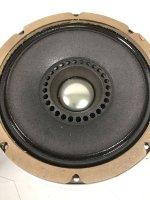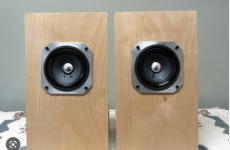Take my fingers and knead them like dough.
edit: Also added little star stick-ons to the dust caps to breakup/damp its HF 'hash'.
edit: Also added little star stick-ons to the dust caps to breakup/damp its HF 'hash'.
Last edited:
Take my fingers and knead them like dough.
edit: Also added little star stick-ons to the dust caps to breakup/damp its HF 'hash'.
Hi GM,
I remember you've mentioned kneading the cone several times and have been wondering how it actually works.
I thought the starch in paper is like concrete; the fiber is like the steel bar. They both serve structural purposes.
We may hold a piece of flat paper at the edge with thumb at the center to make it a little concave, then the stiffness can support it horizontally. But we can't do this to a piece of handkerchief.
I never try it on any speaker cone but had done it on ordinary paper (decades ago in high school during those boring classes). We 'kneaded' the poor piece of paper thoroughly until it got softened as a piece of thin cloth. It can be even softer than tissue paper. I can't imagine such softness and speaker cone would go together.
So, how much should I knead a cone to properly soften it? I guess this would be a touch of art?
(And I guess this can drive those perfectionists crazy when they see all those wrinkles on their beloved whizzers. )
Here in Argentina we had LEEA, a factory which made VERY good speakers under Altec Lansing license, and one model had same multiperforated edge.
They also used the thin aluminum dome glued straight to voice coil, so it was not "cosmetic" or just "a dust cover" but an improvised dome tweeter, it certainly added some highs.
To boot, voicecoils were very short, wound on paper (latest models on Nomex) and using light Nitro type adhesives; those speakers had incredible highs for a 12" speaker, were MUCH used in 4 x 12" columns for Rock Concert PA.
They also used the thin aluminum dome glued straight to voice coil, so it was not "cosmetic" or just "a dust cover" but an improvised dome tweeter, it certainly added some highs.
To boot, voicecoils were very short, wound on paper (latest models on Nomex) and using light Nitro type adhesives; those speakers had incredible highs for a 12" speaker, were MUCH used in 4 x 12" columns for Rock Concert PA.
Last edited:
Here in Argentina we had LEEA, a factory which made VERY good speakers
Interesting, I never heard of them before. I saw on Youtube some guy playing some very nice sounding antique LEEA drivers +here.
Are there any companies in Argentina making good speakers today?
Last edited:
That's not that uncommon. My first intro to it was about 1980 with the Radio Shack 40-1311. Quite a good little 5" driver for the time, including the dome pseudo-tweeter and a cast basket. To this day I wonder if it gave more highs than a whizzer?They also used the thin aluminum dome glued straight to voice coil,
Attachments
- Home
- Loudspeakers
- Full Range
- perforated whizzer cone

